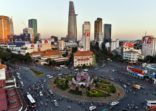Investors can take their pick of headwinds, including weakening currencies, capital flight, stalling reform and geopolitical issues, affecting emerging markets in 2014. And explanations are plentiful as to why they have been so badly hit since the summer of 2013.
While the developed world has been hit by the Fed’s decision to taper asset purchases, should not smaller economies be hit harder? If Turkey or Thailand were to suffer then why not Morocco and Vietnam?
But many economies that make up the EM index are not really “emerging” in the purest sense anymore and so start to decouple from those real emerging economies. For example, the biggest constituent on the EM MSCI is China, which investors debate has the potential to be the most powerful economy in the world.
Haunted reputations
There is no clear definition of what constitutes a frontier market. The 24 economies Morgan Stanley lists on its index can be classified as emerging economies but even as these markets gain credibility, common misconceptions still haunt their reputation.
The total market capitalisation of all stocks on the MSCI Frontier Markets Index is $109bn (£68bn) compared with the $4trn in the equivalent MSCI Emerging Market Index.
Given this relatively small size, many worry about a potential investor rush for the exits. With such thin liquidity, this quick selling could drive volatility brusquely higher.
FTSE data has shown that since the global financial crisis, frontier markets have been less than half as volatile as their emerging counterparts. These supposed prejudices can work to the long-term investor’s advantage as an underdeveloped financial infrastructure can act as a prime incubator to harness future returns.
A contrast can be drawn when highlighting the capital flight from EM during late 2013. The MSCI Frontier Markets index rose by 26% last year while its emerging counterpart fell by 3%. This theme has carried on into 2014, with frontier figures showing a gain of 21.8% year-to-date compared with 2.6% posted by emerging markets.
Frontier markets may once have been a useful supplement in an EM manager’s armoury – a tool used to boost returns whenever sentiment was buoyant on emerging economies – but they are now very much seen as an asset class in their own right, and a credible one at that.
The potential for rapid growth, once seen as a unique selling point of emerging markets, is now a characteristic of the burgeoning frontier sector. Returns posted by EM economies in the 1990s and the early 2000s are now being replicated by today’s frontier markets. Many of the arguments used to build a case for less developed economies back then, resonate now.
In fact, the frontier markets of today are in much better economic shape than their equivalents were 20 years ago. During recent years, inflation has largely been brought under control in many markets, and given several years of strong growth, many current account deficits have transformed into surpluses.
This has created more robust platforms for future growth and, in some cases, has been reflected in improving credit ratings.
Debt to GDP levels are also roughly half that of emerging markets and an eighth of that of developed markets. Reserve levels are also significantly higher than developed markets.
Breaking frontiers
As frontier market economies have improved, they have started to open up to foreign investors.
Government debt markets are growing and many frontier markets support well-functioning stock markets. This robust economic growth is structurally driven by access to capital and technology from the developed world, favourable demographics and a large population base.
Frontier markets encompass a population base of 1.2 billion people, with much younger and faster-growing populations than those of developed or even mainstream emerging markets. Striking evidence of this is that the average age of the population is only 30.2 years, compared with 40.5 years in developed markets.
Despite the positives, the sector still deserves temperance. Though these economies are more stable than a decade ago, events such as the geopolitical situation in North Africa can disrupt investment.
For investors concerned EM performance is increasingly tracking that of developed markets, the lack of correlation frontier countries exhibit as a group is appealing. The lack of correlation between frontier markets themselves, however, is something investors need to monitor thoroughly, as differentiation is key when analysing these budding opportunities.
















